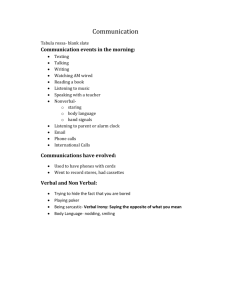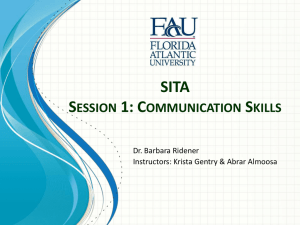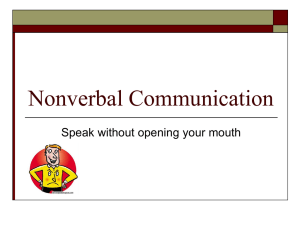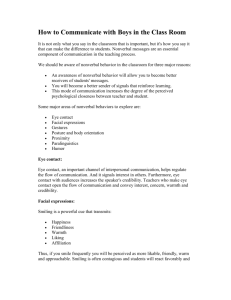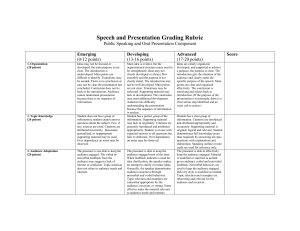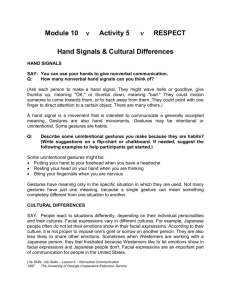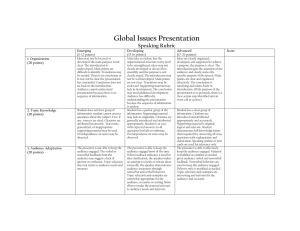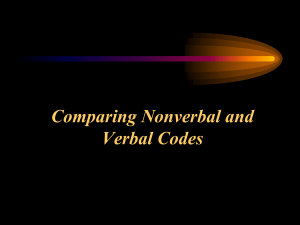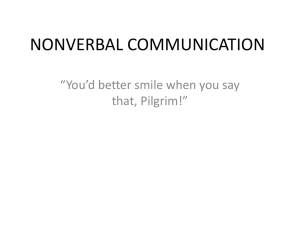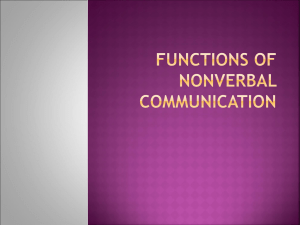Nonverbal Communication and Presentation Techniques
advertisement
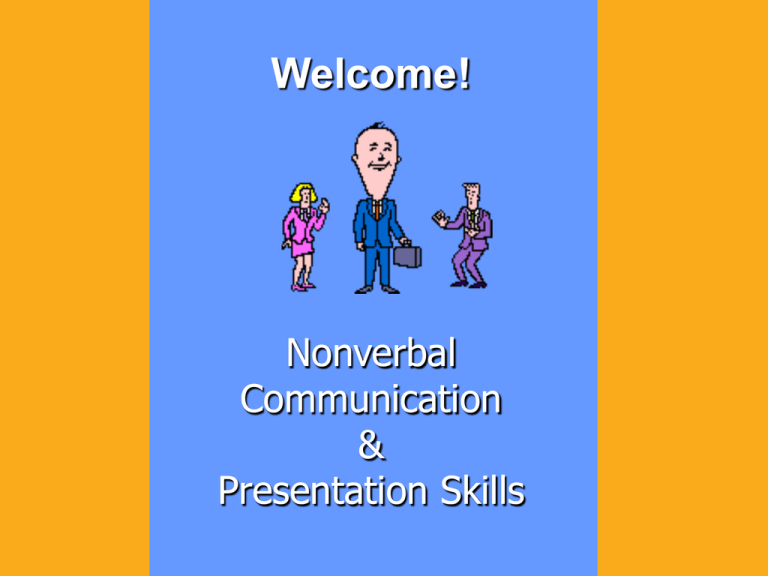
Welcome! Nonverbal Communication & Presentation Skills Communicating Without Words • We all communicate nonverbally • By analyzing nonverbal cues, we can – enhance our understanding – define relationships Cues and Contexts We communicate nonverbally through our bodies and appearance the environment we create and live in Cues and Contexts Nonverbal communication Perpetual Frequently involuntary Verbal and nonverbal messages Clear messages Mixed messages –words and actions contradiction Aspects of Nonverbal Communication Kinesics – the study of body language Facial Expressions = emotion display Posture and Gestures Posture sends messages: Content and confident? Angry and belligerent? Worried and discouraged? Flight or Fight The way you feel about those with whom you are communicating Gestures sends messages: Movements of arms, legs, hands, and feet send messages about us Gestures do not have universal meanings Functions of Nonverbal Communication Message Reinforcement “I love you” & kisses Message Negation “We need to spend less time together” & moving closer Message Substitution Pointing/gestures/ “OK” sign Message Accentuation “I’m so angry!” & pulling on hair Message Regulation eye contact/posture/gestures Signals flow of conversation Clothing and Artifacts Artifactual communication – the use of personal adornments Extremely important in creating a first impression Dress and chosen images should change as our roles change Sometimes the basis for judgments regarding success, character, dominance, and competence Paralanguage Paralanguage – vocal cues that accompany language Pitch Habitual pitch Volume Rate Pauses Nonfluencies Silence Confused Communication • Speech Fillers/Nonfluencies – confuse the listener, with the message becoming garbled – anything that interrupts the message and can include: – – – – – – – UM UH Like OKAY You Know So then Now… Space and Distance Distances Intimate: 0-18 inches Personal: 18 inches to 4 ft. Social: 4 to 12 ft. Public: 12 ft. to limit of sight Spaces Informal: highly mobile and can be quickly changed Semifixed-feature: the use of objects to create distance Fixed-feature: relatively permanent objects to define the environment around us Territoriality and Personal Space – the need to demonstrate a possessive or ownership relationship to space Territoriality – used to establish territory or reserve one’s space Markers Colors Color affects us emotionally and physiologically Some of the emotions colors can trigger: Excitement Warmth Passion and sensuality Happiness Relaxation Persuasion Chronemics Using time to communicate The meaning of time differs around the world “Time talks” Last minute invitations Habitual tardiness Leaving early Allocation of certain activities to appropriate times Structure time differently Haptics Haptics – the study of the use of touch Culturally conditioned Correlates positively with openness, comfort with relationships Can reflect status Valued differently by different cultures Gender and Nonverbal Behavior Visual Dominance – measured by comparing the percentage of looking while speaking with the percentage of looking while listening Men – higher levels of looking while speaking Women – higher levels of looking while listening Gendered Communication Diversity and Nonverbal Behavior Contact cultures vs. Low-contact cultures Different cultures may express emotion or intimacy in different ways Cultural background also affects their use of touch and personal space Identical nonverbal cues may still convey different meanings in different cultures Speaking With Style • Speech Delivery: – Verbal communication – Non-Verbal Communication – Visuals: • Types • Design • How to Use Speaking With Style Speech Delivery: • how you say what you say… – Verbal – Nonverbal Speaking With Style • Verbal communication – Choice of words • Jargon • Slang – – – – – Grammar Enunciation Speech Fillers Vocal variety (pitch/volume) Speedy speakers Speaking With Style Non verbal Communication – What are you doing with your body????? • Body language speaks volumes – Posture – Hand gestures – Facial expressions – Eye contact – Dress/appearance – Body movement/use Speaking With Style Non verbal Communication – What are you doing with your body????? • NO TOUCHING YOUR BODY • No fig leaf stance • No tapping fingers/toes • Don’t clutch podium Speaking With Style Non verbal Communication – Eyes • Full Audience, NOT – …out the window – …on the floor – ..on a spot on the wall – …on your nails… • Note cards – Loss of eye contact minimal – Hands • Emphasis your points • Visual Aid use Speaking With Style Visuals: • Charts • Models • Objects • Electronic Media – – – – Power Point Presentation HTML DVD/Video Pictures (scanned/Internet) • Drawings Speaking With Style Preparing/Designing Visuals: • Size – Can everyone see it? • Photo • Object • Lettering style/size – Power Point Presentation • Size 24 Font Minimum • Slide design • KISS: Keep It Simple…Simon Speaking With Style Preparing/Designing Visuals: • Use – Support/clarify topic – make “visual” your topic – Fluid use • should support speech • not the centerpiece • Look/talk to audience, not visual – Turn off/cover when not in use – DO NOT PASS VISUAL AROUND THE ROOM Speaking With Style • Professional style is key – NO HAND PRINTED POSTERS – NO LAST MINUTE, HURRY UP AND GET IT DONE OBJECTS/MATERIALS Expectations for Speech Makers Society has grown accustomed to high-quality speeches Characteristics of good speakers: Have insight Know their audience Believe what they are doing is important Always practice Think of the speech as a performance Make a critique or post-presentation analysis of the speech Systematic Speaking Process end of presentation
